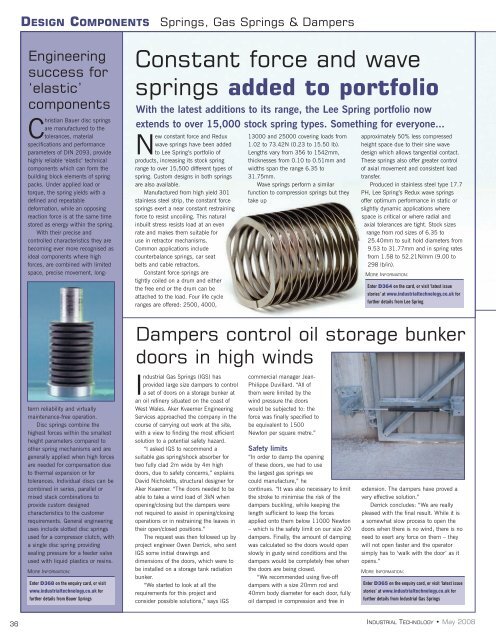sensors & systems - Industrial Technology Magazine
sensors & systems - Industrial Technology Magazine
sensors & systems - Industrial Technology Magazine
Create successful ePaper yourself
Turn your PDF publications into a flip-book with our unique Google optimized e-Paper software.
DESIGN COMPONENTS<br />
Springs, Gas Springs & Dampers<br />
Engineering<br />
success for<br />
‘elastic’<br />
components<br />
Christian Bauer disc springs<br />
are manufactured to the<br />
tolerances, material<br />
specifications and performance<br />
parameters of DIN 2093, provide<br />
highly reliable ‘elastic’ technical<br />
components which can form the<br />
building block elements of spring<br />
packs. Under applied load or<br />
torque, the spring yields with a<br />
defined and repeatable<br />
deformation, while an opposing<br />
reaction force is at the same time<br />
stored as energy within the spring.<br />
With their precise and<br />
controlled characteristics they are<br />
becoming ever more recognised as<br />
ideal components where high<br />
forces, are combined with limited<br />
space, precise movement, long-<br />
Constant force and wave<br />
springs added to portfolio<br />
With the latest additions to its range, the Lee Spring portfolio now<br />
extends to over 15,000 stock spring types. Something for everyone...<br />
New constant force and Redux<br />
wave springs have been added<br />
to Lee Spring’s portfolio of<br />
products, increasing its stock spring<br />
range to over 15,500 different types of<br />
spring. Custom designs in both springs<br />
are also available.<br />
Manufactured from high yield 301<br />
stainless steel strip, the constant force<br />
springs exert a near constant restraining<br />
force to resist uncoiling. This natural<br />
inbuilt stress resists load at an even<br />
rate and makes them suitable for<br />
use in retractor mechanisms.<br />
Common applications include<br />
counterbalance springs, car seat<br />
belts and cable retractors.<br />
Constant force springs are<br />
tightly coiled on a drum and either<br />
the free end or the drum can be<br />
attached to the load. Four life cycle<br />
ranges are offered: 2500, 4000,<br />
13000 and 25000 covering loads from<br />
1.02 to 73.42N (0.23 to 15.50 lb).<br />
Lengths vary from 356 to 1542mm,<br />
thicknesses from 0.10 to 0.51mm and<br />
widths span the range 6.35 to<br />
31.75mm.<br />
Wave springs perform a similar<br />
function to compression springs but they<br />
take up<br />
approximately 50% less compressed<br />
height space due to their sine wave<br />
design which allows tangential contact.<br />
These springs also offer greater control<br />
of axial movement and consistent load<br />
transfer.<br />
Produced in stainless steel type 17.7<br />
PH, Lee Spring’s Redux wave springs<br />
offer optimum performance in static or<br />
slightly dynamic applications where<br />
space is critical or where radial and<br />
axial tolerances are tight. Stock sizes<br />
range from rod sizes of 6.35 to<br />
25.40mm to suit hold diameters from<br />
9.53 to 31.77mm and in spring rates<br />
from 1.58 to 52.21N/mm (9.00 to<br />
298 lb/in).<br />
MORE INFORMATION:<br />
Enter D364 on the card, or visit ‘latest issue<br />
stories’ at www.industrialtechnology.co.uk for<br />
further details from Lee Spring<br />
Dampers control oil storage bunker<br />
doors in high winds<br />
term reliability and virtually<br />
maintenance-free operation.<br />
Disc springs combine the<br />
highest forces within the smallest<br />
height parameters compared to<br />
other spring mechanisms and are<br />
generally applied when high forces<br />
are needed for compensation due<br />
to thermal expansion or for<br />
tolerances. Individual discs can be<br />
combined in series, parallel or<br />
mixed stack combinations to<br />
provide custom designed<br />
characteristics to the customer<br />
requirements. General engineering<br />
uses include slotted disc springs<br />
used for a compressor clutch, with<br />
a single disc spring providing<br />
sealing pressure for a feeder valve<br />
used with liquid plastics or resins.<br />
MORE INFORMATION:<br />
Enter D368 on the enquiry card, or visit<br />
www.industrialtechnology.co.uk for<br />
further details from Bauer Springs<br />
<strong>Industrial</strong> Gas Springs (IGS) has<br />
provided large size dampers to control<br />
a set of doors on a storage bunker at<br />
an oil refinery situated on the coast of<br />
West Wales. Aker Kvaerner Engineering<br />
Services approached the company in the<br />
course of carrying out work at the site,<br />
with a view to finding the most efficient<br />
solution to a potential safety hazard.<br />
“I asked IGS to recommend a<br />
suitable gas spring/shock absorber for<br />
two fully clad 2m wide by 4m high<br />
doors, due to safety concerns,” explains<br />
David Nicholetts, structural designer for<br />
Aker Kvaerner. “The doors needed to be<br />
able to take a wind load of 3kN when<br />
opening/closing but the dampers were<br />
not required to assist in opening/closing<br />
operations or in restraining the leaves in<br />
their open/closed positions.”<br />
The request was then followed up by<br />
project engineer Owen Derrick, who sent<br />
IGS some initial drawings and<br />
dimensions of the doors, which were to<br />
be installed on a storage tank radiation<br />
bunker.<br />
“We started to look at all the<br />
requirements for this project and<br />
consider possible solutions,” says IGS<br />
commercial manager Jean-<br />
Philippe Duvillard. “All of<br />
them were limited by the<br />
wind pressure the doors<br />
would be subjected to: the<br />
force was finally specified to<br />
be equivalent to 1500<br />
Newton per square metre.”<br />
Safety limits<br />
“In order to damp the opening<br />
of these doors, we had to use<br />
the largest gas springs we<br />
could manufacture,” he<br />
continues. “It was also necessary to limit<br />
the stroke to minimise the risk of the<br />
dampers buckling, while keeping the<br />
length sufficient to keep the forces<br />
applied onto them below 11000 Newton<br />
– which is the safety limit on our size 20<br />
dampers. Finally, the amount of damping<br />
was calculated so the doors would open<br />
slowly in gusty wind conditions and the<br />
dampers would be completely free when<br />
the doors are being closed.<br />
“We recommended using five-off<br />
dampers with a size 20mm rod and<br />
40mm body diameter for each door, fully<br />
oil damped in compression and free in<br />
extension. The dampers have proved a<br />
very effective solution.”<br />
Derrick concludes: “We are really<br />
pleased with the final result. While it is<br />
a somewhat slow process to open the<br />
doors when there is no wind, there is no<br />
need to exert any force on them – they<br />
will not open faster and the operator<br />
simply has to ‘walk with the door’ as it<br />
opens.”<br />
MORE INFORMATION:<br />
Enter D365 on the enquiry card, or visit ‘latest issue<br />
stories’ at www.industrialtechnology.co.uk for<br />
further details from <strong>Industrial</strong> Gas Springs<br />
36<br />
INDUSTRIAL TECHNOLOGY • May 2008
















